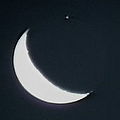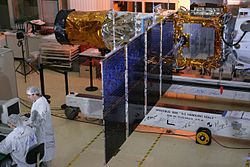astronomy, planetary transits and occultations occur when a planet passes in front of another object, as seen by an observer. The occulted object may...
9 KB (744 words) - 03:04, 21 February 2025
size Lunar occultation of Venus Occultations, transits, and eclipses Planetary transits and occultations Radio occultation Solar eclipse Syzygy (astronomy)...
28 KB (2,718 words) - 14:53, 13 March 2025
Syzygy (astronomy) (redirect from Occultations, transits, and eclipses)
one. In the combined case where the smaller body regularly transits the larger, an occultation is also termed a secondary eclipse. An eclipse occurs when...
6 KB (670 words) - 10:27, 6 April 2025
planet eclipses/transits its host star it will block a portion of the light from the star. If the planet transits in-between the star and the observer the...
18 KB (2,065 words) - 11:07, 14 May 2025
mutual planetary eclipses, including occultations and transits. Although mutual occultations of planets had been recorded in 581, 1170, 1590, and 1737,...
113 KB (1,345 words) - 17:11, 5 March 2025
"109P/Swift-Tuttle Orbit". Minor Planet Center. "Occultation – Mutual planetary transits and occultations – Encyclopedia II". Archived from the original...
93 KB (4,012 words) - 15:47, 14 May 2025
a transit, Venus is visible as a small black circle moving across the face of the Sun. Transits of Venus reoccur periodically. A pair of transits takes...
40 KB (4,192 words) - 21:19, 17 May 2025
occur on November 13, 2032. A typical transit lasts several hours. Mercury transits are much more frequent than transits of Venus, with about 13 or 14 per...
38 KB (3,512 words) - 18:34, 3 April 2025
Methods of detecting exoplanets (redirect from Transit method)
Telescope has been used to detect transits of extrasolar planets, as well as occultations of the planets by their host star and phase curves. The Gaia mission...
138 KB (15,653 words) - 13:55, 29 April 2025
Venus (redirect from Morning and Evening Star)
the transits of Venus and Mercury by 13th-century Maragha astronomer Qotb al-Din Shirazi, though this cannot be true as there were no Venus transits in...
223 KB (20,302 words) - 03:05, 19 May 2025
CoRoT (redirect from COnvection ROtation and planetary Transits - Asteroseismology and Search for Exoplanets)
CoRoT (French: Convection, Rotation et Transits planétaires; English: Convection, Rotation and planetary Transits) was a space telescope mission which operated...
131 KB (14,056 words) - 18:32, 17 May 2025
TRAPPIST (redirect from TRAnsiting Planets and PlanetesImals Small Telescope)
a stellar occultation of the planetary body Eris, revealing that it may be smaller than Pluto, and it helped observe a stellar occultation by Makemake...
8 KB (772 words) - 04:05, 17 May 2025
486958 Arrokoth (redirect from Lobus (planetary geology))
on this string of three occultations, scientists were able to trace out the object's shape. Results of the 2017 occultation campaign Pre-flyby conceptual...
128 KB (10,771 words) - 07:30, 23 April 2025
Eclipse (redirect from Deep occultation)
2007). "Planetary Transits Across the Sun". NASA. Archived from the original on March 11, 2008. Retrieved 2008-03-11. "When will the next transits of Mercury...
41 KB (4,660 words) - 13:19, 3 May 2025
The occult is a category of supernatural beliefs and practices, encompassing such phenomena as those involving mysticism, spirituality, and magic in terms...
12 KB (1,379 words) - 12:13, 12 March 2025
Mercury (planet) (redirect from Mercury's orbit and rotation)
the possibility of planetary transits across the face of the Sun in his work Planetary Hypotheses. He suggested that no transits had been observed either...
156 KB (16,132 words) - 11:44, 19 May 2025
astrophotography, which allows pre-processing and processing of images from any type of camera (CCD, planetary camera, webcam etc.). The images must be converted...
6 KB (626 words) - 19:36, 18 April 2025
Ring system (redirect from Planetary rings)
systems. Ring systems around minor planets have also been discovered via occultations. Some studies even theorize that the Earth may have had a ring system...
39 KB (3,943 words) - 17:24, 11 April 2025
Conjunction (astronomy) (redirect from Planetary conjunction)
solar eclipse. Occultations in which the larger body is neither the Sun nor the Moon are very rare. More frequent, however, is an occultation of a planet...
30 KB (3,701 words) - 13:20, 28 February 2025
Sara Seager (category Women planetary scientists)
atmospheres and developing low-cost space observatories to observe planetary transits. Seager was born in Toronto, Ontario, Canada, and is Jewish. Her...
30 KB (2,515 words) - 07:39, 17 April 2025
J1407b (category Planetary rings)
(March 2012). "Planetary Construction Zones in Occultation: Discovery of an Extrasolar Ring System Transiting a Young Sun-like Star and Future Prospects...
39 KB (3,923 words) - 01:58, 16 May 2025
139 Juewa (category Objects observed by stellar occultation)
ruìhuá.) Since 1988 there have been 8 reported stellar occultations by Juewa. From the occultation on 31 August 2013 the best fit ellipse measures 148.3±4...
7 KB (450 words) - 18:41, 4 May 2025
the size and distance of the occulter. TAOS is sensitive to occultations by Kuiper Belt Objects (KBOs) larger than about 500 m in diameter and to Sedna-like...
4 KB (450 words) - 01:31, 17 August 2022
Satellite of 38628 Huya (category Objects observed by stellar occultation)
detected via stellar occultations in 2021 and 2023.: 9 As of 2025[update], the satellite of Huya has been detected via stellar occultation three times, all...
13 KB (1,269 words) - 19:55, 28 March 2025
3 Juno (category Objects observed by stellar occultation)
for which an occultation was observed. It passed in front of a dim star (SAO 112328) on 19 February 1958. Since then, several occultations by Juno have...
26 KB (2,286 words) - 13:52, 19 March 2025
2 Pallas (category Objects observed by stellar occultation)
collisions with each other. Pallas, Vesta and Ceres appear to be the only intact bodies from this early stage of planetary formation to survive within the orbit...
48 KB (4,374 words) - 09:29, 27 April 2025
In tightly packed planetary systems, the gravitational pull of the planets among themselves causes one planet to accelerate and another planet to decelerate...
11 KB (1,137 words) - 22:03, 2 November 2024
TOI-178 (category Planetary transit variables)
the transits of the various planets, which are expected to range from minutes to tens of minutes, should help pin down the planetary masses and uncover...
13 KB (627 words) - 16:10, 5 April 2024
(523764) 2014 WC510 (category Objects observed by stellar occultation)
by the Research and Education Collaborative Occultation Network (RECON), a citizen science project dedicated to observing occultations by trans-Neptunian...
19 KB (1,829 words) - 01:34, 11 December 2024
TRAPPIST-1 (category Planetary transit variables)
TRAPPIST-1 planetary system have been represented as music, such as Tim Pyle's Trappist Transits, in Isolation's single Trappist-1 (A Space Anthem) and Leah...
188 KB (20,693 words) - 19:04, 19 May 2025





















